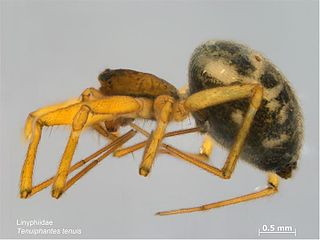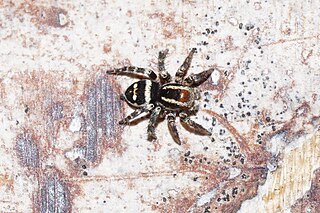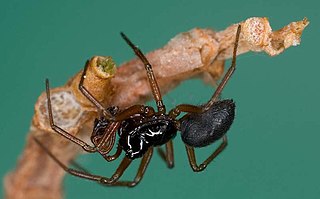
The bowl and doily spider is a species of sheet weaver found in North and Central America. It is a small spider, about 4 mm (0.16 in) long, that weaves a fairly complex and unique sheet web system consisting of an inverted dome shaped web, or "bowl," suspended above a horizontal sheet web, or "doily", hence its common name. The spider hangs from the underside of the "bowl", and bites through the web small flies, gnats and other small insects that fall down into the non-sticky webbing. The webs are commonly seen in weedy fields and in shrubs, and may often contain both a male and a female spider in late summer—like many linyphiids, Frontinella males and females may cohabitate for some time. Males exhibit competition for female mates both by fighting and sperm competition. Uniquely, these spiders exhibit behavioral thermoregulation and have lengthened circadian rhythms.

Linyphiidae, spiders commonly known as sheet weavers, or money spiders is a family of very small spiders comprising 4706 described species in 620 genera worldwide. This makes Linyphiidae the second largest family of spiders after the Salticidae. The family is poorly understood due to their small body size and wide distribution; new genera and species are still being discovered throughout the world. The newest such genus is Himalafurca from Nepal, formally described in April 2021 by Tanasevitch. Since it is so difficult to identify such tiny spiders, there are regular changes in taxonomy as species are combined or divided.

Neriene peltata is a species of spider belonging to the family Linyphiidae. It has a Holarctic distribution.

Microlinyphia is a genus of dwarf spiders that was first described by U. Gerhardt in 1928.

Linyphia triangularis is a European species of spider in the family Linyphiidae first described by Carl Alexander Clerck in his 1758 Svenska Spindlar.

Neriene montana is a species of spider belonging to the family Linyphiidae. With a holarctic distribution, it is found throughout northern Europe.

Tenuiphantes tenuis is a species of spider belonging to the family Linyphiidae. Its native distribution is reported as Europe, Macaronesia, Northern Africa, Turkey, Caucasus, Central Asia. The species was introduced to USA, Chile, Argentina and New Zealand from Europe where it is found throughout.

Lepthyphantes minutus is a species of spider belonging to the family Linyphiidae. Despite its name it is one of the larger species of Lepthyphantes. It is found throughout Northern Europe.

Orsonwelles is a genus of American dwarf spiders that was first described by G. Hormiga in 2002. They are all native to the Hawaiian Islands, each species occurring on a single island, often at high elevations. One species has not been collected since the 1890s, and is believed to be extinct. The name honors the actor and film-maker Orson Welles. Many of the species names commemorate elements from Welles' films, radio productions, or roles.
Agelenella is a genus of Asian funnel weavers containing the single species, Agelenella pusilla. It was first described by Pekka T. Lehtinen in 1967, and has only been found in Yemen.
Estrandia is a monotypic genus of dwarf spiders containing the single species, Estrandia grandaeva. It was first described by H. H. Blauvelt in 1936, and has only been found in China, Japan, and Russia.

Frontinellina is a genus of dwarf spiders that was first described by P. J. van Helsdingen in 1969. As of May 2019 it contains only three species, found in Kazakhstan, Portugal, Russia, South Africa, and Turkey: F. dearmata, F. frutetorum, and F. locketi.
Locketina is a genus of Southeast Asian dwarf spiders that was first described by A. O. Kocak & M. Kemal in 2006. As of May 2019 it contains only three species, found in Indonesia and Malaysia: L. fissivulva, L. pusilla, and L. versa.

Stenaelurillus specularis is a species of jumping spider in the genus Stenaelurillus that the endemic to Malawi. It was first described in 2014 by Wanda Wesołowska. The spider is small, with a brown cephalothorax between 2.1 and 2.8 mm in length and a black abdomen between 2.6 and 3.2 mm long. The carapace has two white streaks and the female abdomen has a triangular-shaped white marking. It is distinguished from other members of the genus by the male's shiny black area on the abdomen, after which the species is named. and the female's short, wide epigyne that has two large oval copulatory openings.

Stenaelurillus iubatus is a species of jumping spider in the genus Stenaelurillus that in endemic to Nigeria. It was first described in 2011 by Wanda Wesołowska and Anthony Russell-Smith. The spider is medium-sized, with a brown carapace between 2.7 and 2.95 mm in length and abdomen between 2.3 and 3.25 mm in length. The male has two stripes of white scales on the carapace and the female has a heart-shaped white spot on the abdomen. The spider has a distinctive mane-like long hairs on its black eye field, which is recalled in the species name that is derived from the Latin for mane. It can be distinguished from other species in the genus by the ribbon-shaped embolus on the male and highly sclerotized epigyne with its narrow pocket and widely separated copulatory openings on the female.
Linyphia rita is a species of sheetweb spider in the family Linyphiidae. It is found in the United States.
Microlinyphia mandibulata is a species of sheetweb spider in the family Linyphiidae. It is found in the United States.

Erigone atra is a species of dwarf spider or money spider, in the family Linyphiidae. It is commonly found in North America, Europe, parts of Russia, Central Asia, China, Mongolia, Korea, and Japan. This spider is one of the most common Erigone spiders. E. atra is an important spider for agriculture, as it preys on pests such as aphids which are commonly found on crops. E. atra spiders are aeronautical spiders, as they travel via ballooning. This technique, sometimes referred to as kiting, allows E. atra spiders to traverse large distances and find new habitats when environmental or human stresses create unfit living environments. E. atra is difficult to differentiate from other congeneric species because of their similar sizes and coloring.
Staveleya is a genus of European sheet weavers. Its current name is a replacement for Hypsocephalus, already a genus in the snapper family of fish. The type species was originally described under the name "Microneta pusilla", but the type species is designated one of the junior synonyms, "Cnephalocotes dahli" because it has a physical specimen. The genus is named in honour of Eliza Fanny Staveley, the first woman to publish research on arachnology in the United Kingdom.













